Nuts: Nuts (also known as Peanuts, Two-Handed Solitaire or Team Solitaire) is another game which bears a striking resemblance to a solitaire game but is designed for multiple players. It is essentially a team version of Nertz. This game is designed for four players, playing in two partnerships. The game requires the use of two standard 52 card decks. Each deck should have a different back design to allow the decks to be reconstituted after each hand and for easy recognition in scoring of the hand.
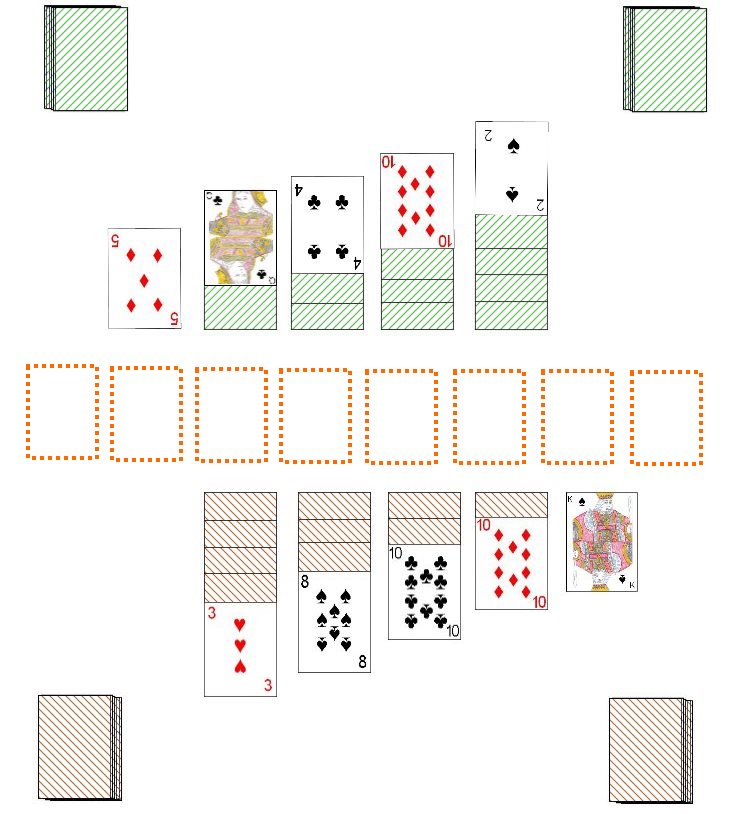 Determination of partnerships and seating positions can be done in a variety of ways with drawing of cards from a shuffled deck a common method. As opposed to many other partnership type games, the two partnerships usually sit alongside each other at the table rather than across the table from each other.
Determination of partnerships and seating positions can be done in a variety of ways with drawing of cards from a shuffled deck a common method. As opposed to many other partnership type games, the two partnerships usually sit alongside each other at the table rather than across the table from each other.
One of the players from each partnership then shuffles one deck thoroughly and then counts off the top 11 cards from the deck in a face down pile on the table (the cards in this pile are called the Nut cards). He then lays the remainder of that deck next to this pile, also face down (this pile is called the Cards pile). This player then passes both piles to the opposing players, directly across the table, such that each partnership is using the piles shuffled and dealt by the opposing team. The player in the partnership for the hand then picks up the Nuts pile of cards and his partner picks up the Cards pile. Neither player should yet look at the faces of these cards. The player who shuffles on each hand should alternate between the two players in each partnership.
The player who has the Cards pile then creates a tableau in front of themselves. Similar to various forms of solitaire, this consists of several columns of cards, with the top card of each row face up and all cards under this card dealt face down. Thus, he first deals a row of five cards on the table in four distinct columns, four cards face down and the fifth card face up. He then deals another row on top of the last row, this time consisting of four rows. No additional card is added to the row consisting of the face up card. The last card of this second row is also dealt face up. He then deals a row of three cards, one card on each row in which each card has previously been dealt face down, with the last card in the row dealt face up. He continues until he has completed the five columns of cards, with the top card of each row face-up. This complete tableau is called the Table Cards. He then sets the remaining cards in a face-down pile, near the Table cards. This remainder of the Cards pile is still referred to as the Cards pile. That player's partner then turns over this Cards pile, face up in a pile, such that only the top card of the pile is visible and playable at a time.
Once both partnerships have arranged his hand in this way, a designed player then announces "Start" which begins play of the hand. There are no actual turns in this game with all players making moves when and as able. The object of the game is to be the first partnership to successfully play his entire Nuts card pile to his own center layout, while at the same time attempting to maximize cards played in the center layout for scoring potential (see below).
The legal plays a player can make are as follows:
- Table Cards: A card may be played from the top card of the Nuts cards pile or the current top card of the Table cards pile to his own tableau. When playing cards to this tableau, a card can be placed on the top card of one of these piles if the card played is exactly one rank lower than the current card and must be of the opposite color (red on black and black on red). As in most forms of solitaire, if a group of cards can be moved from one pile to another in the tableau, he may do so, as long as the play retains this direct ordering and alternating color. If moving a card or pile in this way exposes one of the face down cards, he then turns this card over leaving it in its place at which time it is then considered part of this tableau. If the last card in a row of that team's tableau is created by moving or playing this card to another pile, this space may be filled with the top card of the waste pile, the top card of the Nuts pile or another card from the tableau.
- Center Cards (Foundation Piles): If a player has any Ace he may immediately play this card to the Center pile. Additional cards, from either partnership can then be played on top of this Ace. In order to play a card on an existing center pile, the card must be exactly one higher in rank and of the same suit as the previous card in that pile.
Once the Nuts player has played the last card from his Nuts card pile, he shouts "Nuts" which immediately terminates the hand. At this time, this hand is then scored. One player gathers all the cards played to the Center and divides these cards into piles played by each team (distinguished by the back design of the deck). The players who were in charge of the Nuts cards during the hand then count the number of cards remaining in their Nuts card piles (if any). The final score for each partnership is the total number of cards played to the center subtracted by two times the number of Nuts cards remaining in his own teams Nuts cards pile. Negative scores are possible and should be recorded as such.
After scores are tallied for the hand, the decks are reformed, reshuffled and a new hand is dealt. The first team to reach or exceed 250 points at the end of a hand is declared the winner of the game.
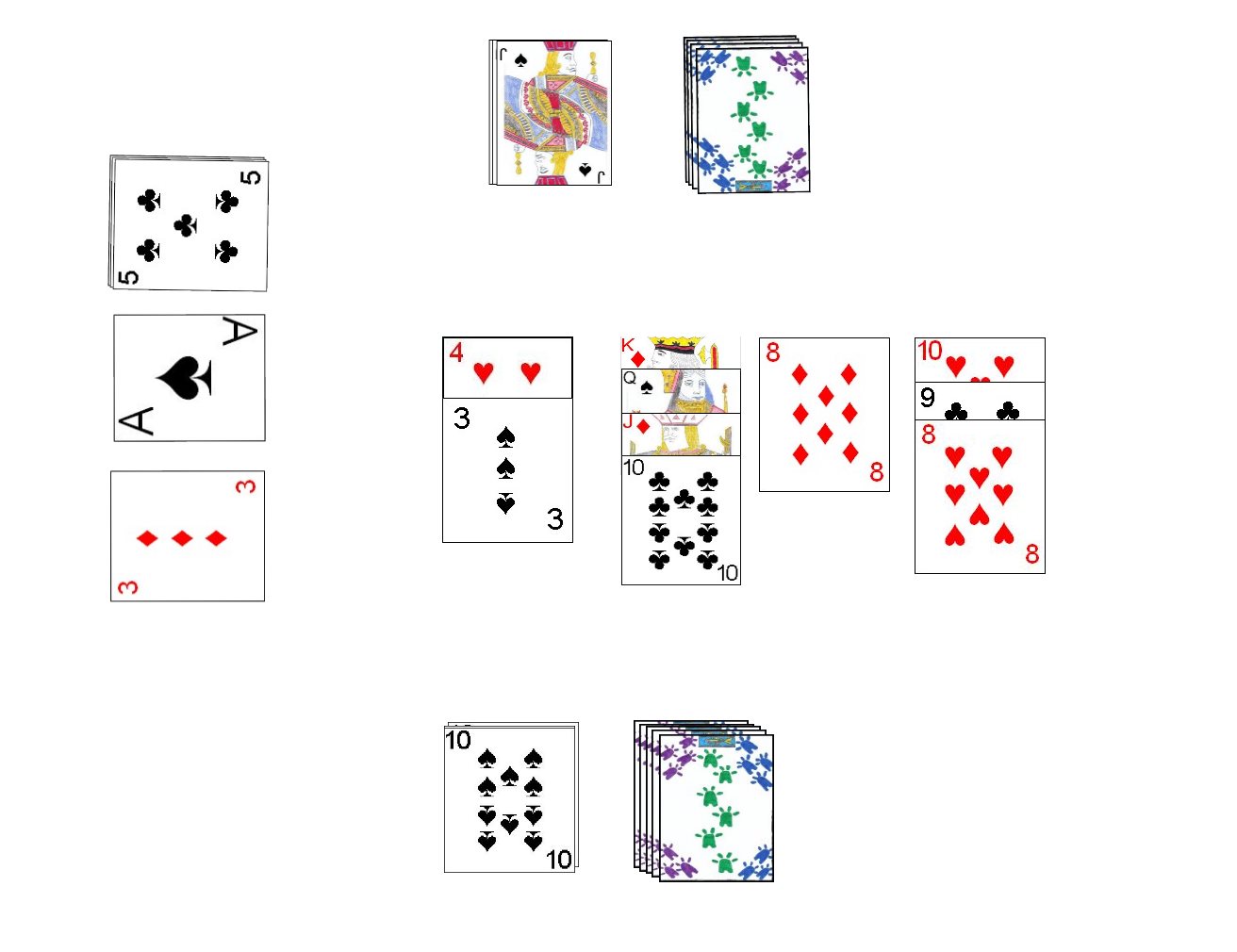 Double Solitaire - Simplified Version: Another two-player game which is played similar to Spite and Malice
and Nertz is this version of Double Solitaire. This game should not be confused with another somewhat
more complex game called Double Solitaire in which more elaborate center foundations are used. The rules for that version of Double Solitaire are described on another page.
Double Solitaire - Simplified Version: Another two-player game which is played similar to Spite and Malice
and Nertz is this version of Double Solitaire. This game should not be confused with another somewhat
more complex game called Double Solitaire in which more elaborate center foundations are used. The rules for that version of Double Solitaire are described on another page.
This variant uses one standard deck with no Jokers added. The ranking of the cards used in the deck is as follows (from high to low); King, Queen, Jack, 10, 9, 8, 7, 6, 5, 4, 3, 2, Ace.
Determination of first dealer can be done in any of the standard methods, with drawing for high card probably the most common. After the first dealer is determined, he thoroughly shuffles the deck and offers it to his opponent to cut. After the cut, he then deals four cards face up on the table to begin the foundation piles. After doing this he then deals out the remainder of the cards alternating between his opponent and himself. These are dealt in a face down stack in front of each player. Before the start of the game (and before any cards in the piles are seen by either player) the dealer's opponent may ask to exchange his pile for the dealers, which the dealer must honor if requested.
The dealer's opponent then has the first turn. To begin his turn he picks up the top card of his stock pile. He may then make any available plays using this card and any other cards on the board. The following are the legal plays a player can make on his turn:
- A player may play the card he flipped over to any of the center piles. The center piles are played to in descending sequence order. In addition, as in many solitaire type games, these descending cards must be played in alternate colors. Thus, a red card of the next lowest rank would be required on a black card. If a player manages to play his card drawn from his stock pile, he then picks up the next card in that pile.
- Merging center stacks. If the top card of any of the center stacks can legally be played onto the top of another center stack, the player may do so. This would create an empty space in which the player can fill with any card of his choice to begin a new center stack.
- Side Stacks. Similar to Spite and Malice, the players can begin four side stacks. However, in this game, the side stacks are communal stacks, owned by both players. Thus, both players can play to and from these stacks. These stacks must start with an Ace, building to King in ascending sequence. There may be four such side stacks and each stack must be of one specific suit. On his turn a player may play any number of cards to these stacks. If any of a players exposed cards (either from his personal stock pile or the center piles) can legally be played to the side stacks he must play the card.
- If the player has any cards on his own discard pile he may play the top card of the discard pile to any of the other stacks as appropriate.
- If the opponent has a discard pile (which every player should have after the first turn), he may play cards on top of that discard pile in an ascending or descending sequence. Similar to the center piles, the cards must be played in alternating color (red on black and black on red). Cards can be played to this stack from the center piles, side stacks or the players own discard pile.
If on a player's turn he finds that his stock pile has been depleted (but he still has a discard pile), he simply turns his entire discard pile over (without shuffling) to start a new stock pile.
The game continues until one player is able to play all cards from his discard and stock pile, at which time he is declared the winner of the game.
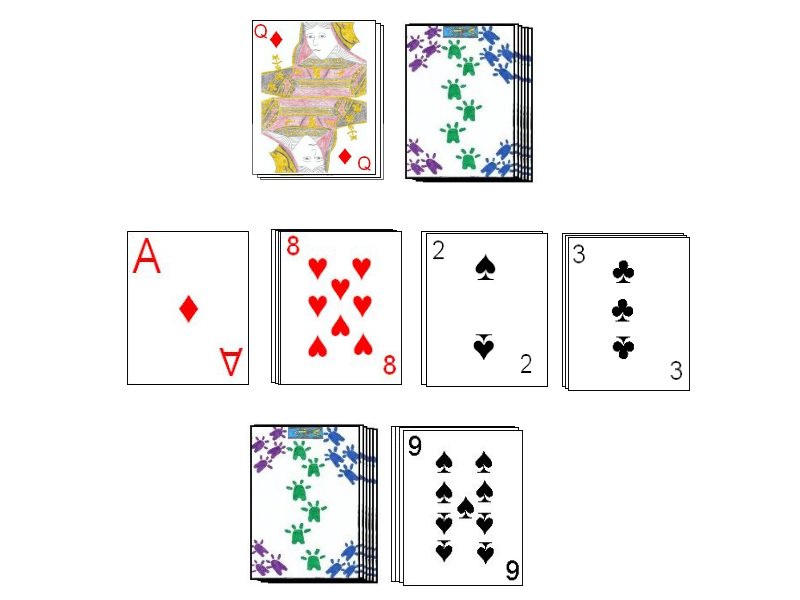 Pishe Pasha: Pishe Pasha is a game played very similarly to Double Solitaire and is designed for two players using one standard deck. It should not be confused with the similarly named but unrelated game Pisha Pasha which is a variant of the game War. The rules for that game can be found at this link.
Pishe Pasha: Pishe Pasha is a game played very similarly to Double Solitaire and is designed for two players using one standard deck. It should not be confused with the similarly named but unrelated game Pisha Pasha which is a variant of the game War. The rules for that game can be found at this link.
To begin the dealer deals out a stack of 26 face down cards to each player. The dealer's opponent has the first turn. On this first turn, the dealer's opponent simply turns over the top card of his stack. If this card is not an Ace, he sets it beside his stock pile and ends his turn. If the card is an Ace, he places it face-up in the center of the table to start a foundation pile for cards of that suit to be played on in an ascending order. In that case, the dealer's opponent then turns up the next card from his stock pile. If the card is another Ace or a card that can be played on top of any other card already found in the foundation pile he must play it. A card can be played to an existing foundation pile if it is the next highest card in sequence of that same suit. The dealer's opponent continues play in this manner until the card drawn from the stock cannot legally be played, after which he then places the card to start his discard pile, ending his turn.
After the dealer's opponent completes his turn, the dealer then begins his turn. He also turns over the top card of his own stock pile and has the same options for his turn as did his opponent. However, he also has one other option. If his card is exactly one rank or higher than the top card of his opponent's discard pile (regardless of the suit of that card) he may opt to play the card onto the top of that pile. As did his opponent, he continues turning cards from his stock pile until he no longer has any legal plays, after which he places the unplayable card to start his own stock pile.
After each player has had his first turn, the turn then alternates between each player, starting again with the dealer's opponent. On each of these turns, the player begins by making any plays from his discard pile to the foundation piles if that card is of the same suit and the next card in sequence of the card currently found on the top of the foundation pile. Additionally, if the top card of the discard pile is exactly one rank higher or lower then the current top card (regardless of suit) of his opponent's discard pile he may play the card to the top of the discard pile. Plays to the foundations are mandatory but plays to the opponent's discard pile are optional for the player. Once he no longer has any mandatory plays and no plays he wants to make (or his discard pile is empty), the player then turns over the next card of his stock pile. If he is able to make a legal play to the foundations with that card he must make that play. He may also optionally play the card to his opponent's discard pile if the card is exactly one rank higher or lower than the top card on the discard pile (irregardless of suit). He may also make further plays from his discard pile if able. Plays to the foundation from the discard pile always must be played, while plays to the opponent's discard pile are optional. Once the card drawn from the top of the player's stock pile is not played, the player places it face up on the top of his discard pile.
This continues, with the turns alternating between each player. If a player depletes his stock pile, but still has cards in his discard pile, when he is ready to draw the next card from that pile during his turn, he simply turns over the discard pile to create a new stock pile. His first discard will then create a new discard pile for that player.
The game continues in this way, with the turns alternating until one player manages to play every card form his stock and discard pile, after which time he is declared the winner. He then scores one point for each card remaining in his opponent's stock and discard piles.
If a player notices that his opponent has made an incorrect move, or failed to make a mandatory play during his turn he may call "Stop". Upon a valid call of "Stop" the player making the call may either require his opponent to correct the move or may require his opponent to immediately terminate his current turn, with his opponent then beginning his next turn.
Canfield: Canfield is a solitaire game from which Nertz appears to have been based. It plays very similarly to Nertz, but is designed to be played by one player and uses one full 52 card deck. Canfield is sometimes mistakenly called Klondike, but Klondike is a distinctly different solitaire game (described at this link). Canfield was created by Richard A. Canfield in the 1890's.
To begin, the deck should be thoroughly shuffled. After the shuffle, the player then creates a layout on the table in front of himself.
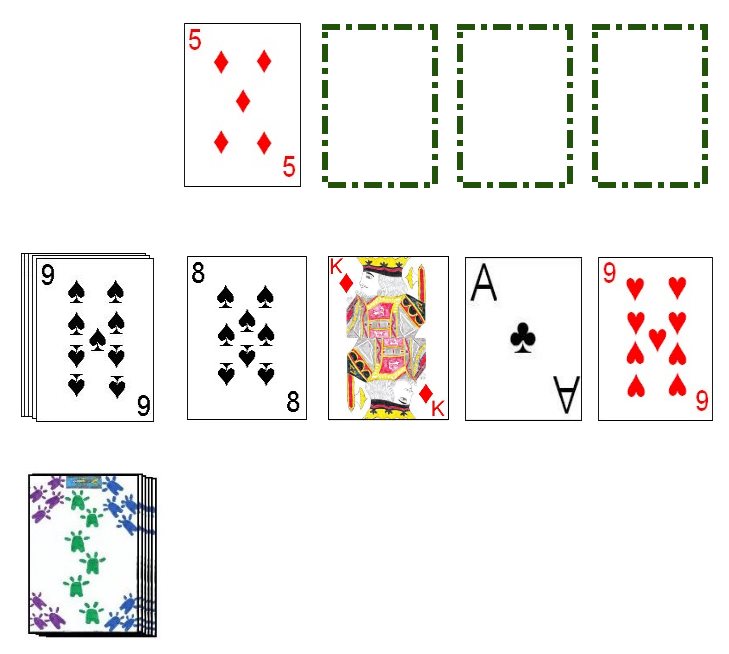 He first deals thirteen cards face up in a pile to his left. He should ensure that none but the top card of this face-up pile is visible at any one time. This pile is called the reserve. He then deals the next card from the stock face-up to be his first foundation pile. The rank of this card should be noted as this is the foundation card which each foundation pile must start. After this first foundation card, he then deals, below the foundation card, four face-up cards in a row. These are the tableau piles. After dealing these four cards he places the remainder of the deck face-down on the table as the draw pile or stock.
He first deals thirteen cards face up in a pile to his left. He should ensure that none but the top card of this face-up pile is visible at any one time. This pile is called the reserve. He then deals the next card from the stock face-up to be his first foundation pile. The rank of this card should be noted as this is the foundation card which each foundation pile must start. After this first foundation card, he then deals, below the foundation card, four face-up cards in a row. These are the tableau piles. After dealing these four cards he places the remainder of the deck face-down on the table as the draw pile or stock.
After creating the layout, play of the hand begins. There are several legal play types a play can make during the game, as follows:
- Foundation Piles : The player may start a new foundation pile or add to a foundation pile already created. To start a new foundation pile, the card must be of the same rank as the original foundation card first played (but will be of a different suit). To build on an existing foundation pile, the card must be the next highest rank as the current top card of that foundation pile, but of the same suit. Since the foundation piles usually will not start with an Ace (depending on the specific card dealt to start the first foundation), after a King is played, the foundation pile then rolls over to Ace and builds again. A player may play the top card of his reserve to the foundation, the top card from a tableau pile or the top card of the discard pile (see below).
- Tableau Piles : A card may be played to a Tableau pile from the reserve, the discard pile or from another tableau pile. Only the top card from one table pile may be played to another tableau pile. In order to be played to the top of a tableau pile, a card must be of the next lower rank and of the opposite color (i.e. red on black or black on red). If, by playing cards from the tableau, an entire tableau pile is depleted leaving an empty space, the top card of the reserve should be immediately used to fill this space. If the reserve is depleted, the player may, whenever he opts, fill this space with a card from the discard pile or from the top card of another tableau pile. A stack of cards can be moved from one tableau to another as long as the cards are moved as a unit and the movement results in valid stacks.
- Stock and Discard Pile : As the player sees fit, he may opt to use cards from the stock pile in play. In order to do this, he deals three cards face up in a pile to a discard pile. The top card of this discard pile can then be played as legal (to the foundations or the tableau). Once the top card of the pile is played he may then play the next card and so on. When the top card of the discard pile is not playable, he may then deal three more cards to the discard pile from the stock pile, continuing this until the stock pile has been completely dealt. In this event, if any cards remain in the discard pile, the player simply flips over this discard pile (without shuffling) to start a new stock pile.
Copyright © 2015 CatsAtCards.com. All rights reserved.
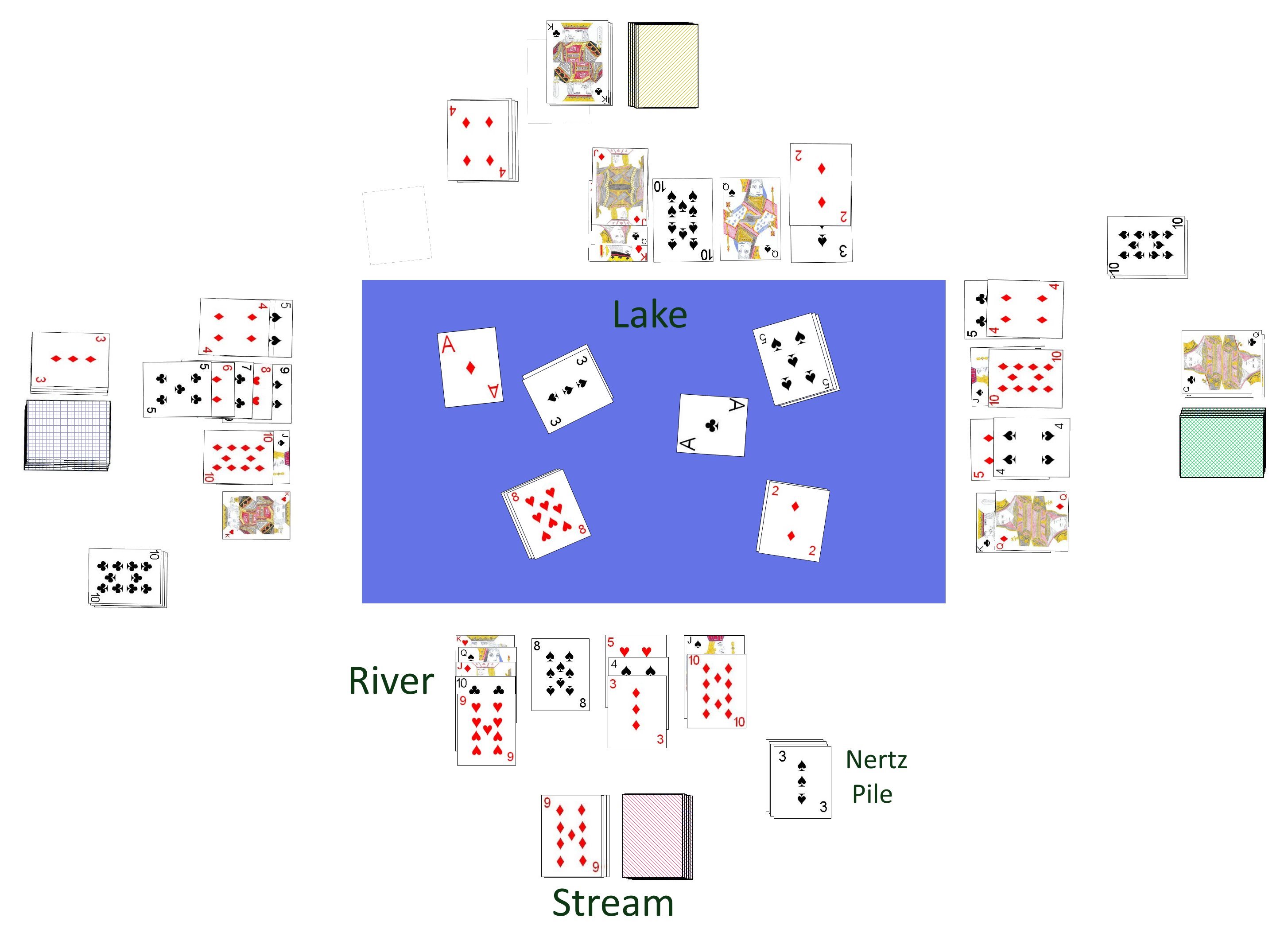 In this game there are no actual turns, with all players playing simultaneously as legal plays are discovered. There are a number of legal plays a player can make during play:
In this game there are no actual turns, with all players playing simultaneously as legal plays are discovered. There are a number of legal plays a player can make during play: